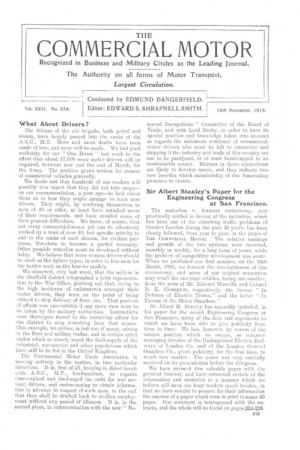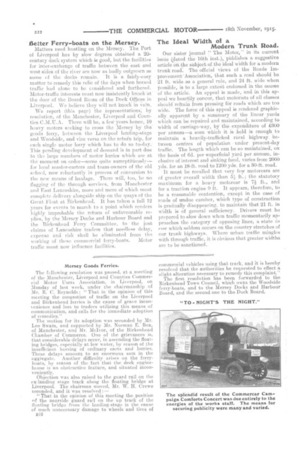COMMERCIAL MOTOR
Page 1

Page 2

If you've noticed an error in this article please click here to report it so we can fix it.
Recognized in Business and Military Circles as the Leading Journal.
The Authority on all forms of Motor Transport. Largest Circulation.
r Conducted by EDMUND DANGERFIELD.
Vol. XXII. No. 558. Editor: EDWARD S. SHRAPNELL-SMITH. 18th November, 1915,
What About Drivers ?
The drivers of the old brigade, both petrol and steam, have _largely passed into the ranks of the A.S.C., M.T. More and more drafts have been made of late, and more will be made. We had good authority for our " One Hears " last week to the effect that about 17,000 more motor drivers will be required, between now and the end of March, for the Army. The position grows serious for owners of commercial vehicles generally.
We doubt not that hundreds of our readers will possibly now regret that they did not take stepson our recommendation, a year ago—to look about them as to how they might arrange to train newt drivers. They might, by confining themselves to men of 40 or older, at least have satisfied some of their requirements, and have avoided some of their present difficulties. We know, of course, that not every commerciahmotor job can be effectively worked by a man of over 40, but specific activity to add to the ranks of such drivers, for civilian purposes, threatens to become a partial necessity.
Other possible remedies must be developed without, delay. We believe that more women drivers should be used on the lighter types, in order to free men for the harder work on the heavier models.
We observed, only last week, that the millers in the Sheffield derict telegraphed a joint representa tion to the War Office, pointing out that, owing to the high incidence of enlistments amongst their motor drivers, they were on the point of being obliged to stop delivery of flour, etc. That position of affairs was unavoidable if any more men were to he taken by the military authorities. Instructions were thereupon issued to the recruiting officer for i he district to stop recruiting from that source. This example, we gather, is but one of many, arising in the flour and milling trades, and in certain other trades which so closely touch the food-supply of the industrial, war-service and other populations which have still to be fed in the United Kingdom.
The Commercial Motor Users Association is moving actively in the • matter, in two particular directions. It. is, first of all, keeping in direct touch with A.S.C., MT,, headquarters, as regards time-expired and diseharged (as unfit for war service) drivers, and endeavouring to obtain information in advance in respect of such men, to the end that they shall be drafted back to civilian employment without any period of idleness. It is, in the second.place, in communication with the new" Re served Occupations " Committee of the Board of Trade, and with Lord Derby, in order to have its special position and knowledge taken into account as regards the minimum residuum of commercialmotor drivers who must be left to commerce and shipping if the industry and trade of this country are not to be paralysed, or at least handicapped to an inadmissible extent. Matters in these connections are likely to develop apace, and they indicate two new benefits which membership of the Association promises to ensure.
Sir Albert Stanley's Paper for the Engineering Congress at San Francisco.
. The motorbus v. tramcar controversy, now practically settled in favour of the motorbus, which has been one of the absorbing traffic problems of Greater London during the past 10 years, has been closely followed, from year to year, in the pages of THE COMMERCIAL MOTOR. The relative earnings and growth of the two systems were recorded, monthly or weekly, for a long term of years, while the problem of competitive development was acute. When we published our first number, on the 16th March, 1905, we foresaw the inevitableness of this controversy, and some of our original supporters may recall the one-page articles, facing one another, from the pens of Mr. Edward Manville and Colonel R. E. Crompton, respectively, the former " In Defence of Electric Trams," and the latter " In Favour of the Motor Omnibus."
Sir Albert R Stanley has naturally included, in his paper for the recent Engineering Congress at San Francisco, many of the data and arguments to which we have been able to give publicity from time to time. Tie has, however, by reason of the unique position which he enjoys, as common managing director of the Underground Electric Railways of London Co. and of the London General Omnibus Co., given publicity, for the first time, to much new matter. The paper was very cordially received on its presentation before the Congress.
We have perused this valuable paper with the greatest interest, and have extracted certain of the information and statistics in a manner which we believe will save our busy readers much trouble, in that we have sought to present for their information the essence of a paper which runs in print to some 40 pages. Our comment is interspersed with the extracts, and the whole will be found on pages...g.4446..
Better Ferry-boats on the Mersey.
Matters need hustling on the Mersey. The Port of Liverpool has by slow degrees obtained a 20, century dock system which is good, but the facilities for inter-exchange of traffic between the east and west sides of the river are now as badly outgrown as some of the docks remain. It is a fairly-easy matter to remedy this relic of the days when horsed traffic had alone to be considered and furthered. Motor-traffic interests must now insistently knock lathe door of the Board Room of the Doek Offi:ces in Liverpool. We believe they will not knock in vain..
We report (this page) the representations, by resolution, of the Manchester, Liverpool and Counties C.M.U.A. There will be, a fessyears hence, 10 heavy motors sseking to cross the 'Mersey. by the goods ferry, between the Liverpool landing-stage and Woodside, and vice versa on the isituin trip, for each single motor lorry which has to do So to-day.. This pending development of demand is in part due to the large numbers of motor lorries which are at the. moment on order—some quite surreptitiously-for local master-carters and team-owners of the old sehool, now reluctantly in process of cOnversion to the new means of haulage. There will, too, be no flagging of the through services, from Manchester and East Lancashire, more and mare of which must complete delivery alongside ship on the quays of the Great float at Birkenhead. It has taken a full 12 years for events to march to a point which renders highly improbable the return of unfavourable replies, by the Mersey Docks and Harbour Board and the • Birkenhead Ferry Committee, to the just claims of Lancashire traders that needless delay, cspense and risk shall be eliminated from the working of these commercial ferry-boats. Motor traffic must now influence facilities.
The Ideal Width of a Modern Trunk Road.
Our sister journal The Motor.," in its current issue Cdated the 16th. inst.), &Wishes a suggestive article en the siilject.of the ideal width for a modern trunk road: The official views of the Roads Improvement-Association, that such a road should be 21 ,ft. wicle.as a general rule, and 24 ft.. wide when Possible, is to a large extent endorsed in the course of the article. An appeal is made, and in this appeal we heartily concur, that motorists of all classes should refrain from pressing for roads which are too wide. The forceof this appeal is rendered graphically apparent by a summary of the linear yards which can be repaired and maintained, according to width of carriage-way, by theexpenditure of 00 per Gum which it. is .held is enough to maintain a heavily-trafficked rinal highway. between .centres of population under present-day traffic. The length which can be so maintained, on the basis of 6d, per superficial yard per annum, inclusive of interest and sinking fund, varies from 2000 yds. for an 18-ft. road to 1200 yds. for a 30-ft. road.
It must be recalled that very few motorcars are of greater overall width than 5,1 ft.; the statutory maximum for a heavy motorcar is ft., and for a traction engine 9 ft. it appears, therefore, to be a reasonable contention, except in the case of roads of undue camber, which type of construction is gradually disappearing, to maintain that. 21 ft. in width is of general sufficiency. Drivers must be prepared to Glow down when traffic momentarily approaches the category of opposing lines, a state in esse which seldom occurs on the country stretches of. our trunk highways. Where urban traffic mingles with through traffic, it is obvious that greater widths are to be sanctioned.






















